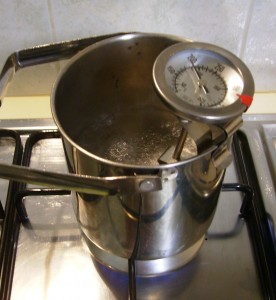This post is wrong!! It’s been pointed out that adding salt to boiling water raises the boiling point. It doesn’t lower it. So something very strange was happening in the experiment below. Perhaps it was just a screwy thermometer??
Just for a change, here’s a post about Chemistry. Or Physics, some might argue. I say Chemistry.
My son had just finished some questions in a science workbook, and I had to mark it. Unfortunately, there was one question I didn’t know the answer to – does adding salt to water lower its boiling point?

So, I got a pot of water and a deep-fry thermometer. Onto the stove they went. I also got a stopwatch and a piece of paper, and made my son record the times and temperatures every couple of minutes. Later I got him to draw a graph of all the points.
As might be expected, when the water was being heated, the temperature went up.
Then the water started boiling – and although the gas hob was still pumping heat into the pot, the temperature stayed stock still at 94° C (that’s 201° F) for the next 5 minutes. Hopefully this drove home to my son that when something’s boiling (or melting), it’s gaining heat but the temperature isn’t changing.
Then we let it cool down a bit, and I added a handful of salt to the hot water.
Switching on the gas again, we kept an eye on the temperatures as the salty water bubbled and boiled. It was fascinating. The salty water started boiling at 87°C (189°F). This, at least, answered the initial question – salty water has a lower boiling point than pure fresh water – but how much lower? The answer to this presumably depends on the amount of salt. The more salty the water, the cooler it will boil.
Then the magic happens – as the salty water boils, the water goes off as steam, but the salt stays put. The boiling water gets saltier and saltier. The boiling point drops. We saw this happen, right there in the kitchen. It was quite unexpected (to me at least). After 5 minutes of pumping heat into the salty water, the temperature had dropped to 82°C (180°F). When we finally stopped the experiment, it was all the way down to 78°C, or 172°F, and still bubbling as vigorously as it had at the start.
So, here’s a nice puzzle, that (I suspect) most people won’t know how to solve. Feel free to baffle and irritate your friends with it.
Name something that gets cooler when you add heat to it.
The answer, you (and I) now know, is
Boiling Salty Water. Wrong! Salty Water has a higher boiling point. And as you boil it away, the temperature increases.
And you can prove this to your skeptical friends with a deep frying thermometer (or other suitable thermometer), a pot, a stove, water and salt. The stopwatch, pen, paper and graph are just icing on the cake.
Incidentally, my son asked why the tap water (with no salt added) boiled at 94°C/201°F instead of 100°C/212°F. In the light of this post, can you guess?